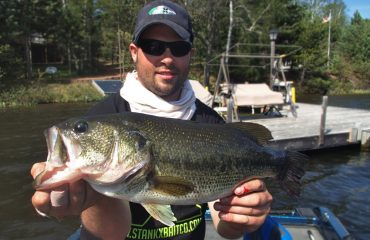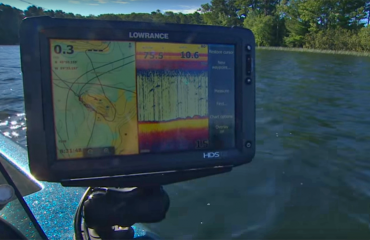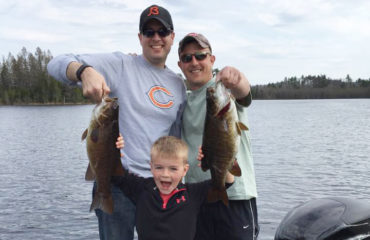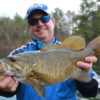Catching Smallmouths This March and April (hopefully)
Most years, I strive to be the first angler on the water targeting smallmouths at ice out. Doing this well before everyone else has become a unique fishing experience.
While catching smallmouths from 39 to 42-degree water temperature is not an easy task across every Northwoods lake, results can be achieved if you are prioritizing locational concepts and employing a thorough, slow strategic approach.
Currently, we must fish really slow, and also disregard about 99% of our tackle.
Whenever ice out occurs (some years early, others late) is dependent upon several weather-related factors and variables. Historically, cold winters with deep snowfall amounts and lots of ice cover can lead to a slower and later ice-melt process, delaying the arrival and progress of spring. Meanwhile, mild and snow-less winters like we’ve had up to this point this year have already, and rather quickly, begun the ice melt process, and many of us are yearning for open water by as soon as the turn of April.
March and April Smallmouths
Nowadays, targeting bass in March and April is now legal in Wisconsin under strict catch and release / no possession enforcement. Imagine if we still lived this way prior to 2019.
It’s no secret that ice-out fishing can be fantastic, and is even better on certain waters more so than others – especially smaller lakes and rapidly-warming flowages.
While the spawning migrations are nowhere close to occurring, dormant smallmouths awaken and begin their movements in seeking warming water and locating food sources to replenish themselves on. Their initial feeding will not be aggressive or bingeworthy once water temperatures climb throughout the 50’s.
Until the spring movements begin, there will be a bounty of challenges awaiting you. The biggest struggle you will endure will be the lack of midday and afternoon feeding windows, difficulties with locating any staging and schooling of fish, and noting the inconsistencies and differences of every lake in which smallmouths were living between 3 different seasonal phases (post-winter, pre-spawn, and spawn). This will make finding fish on a daily basis challenging, and likely also confuse them too.
Furthermore, up here, seasons change rapidly and weather patterns evolve quickly. During warm spells, we can go from winter to spring in 2 weeks or less. Be aware that lakes can warm rapidly following ice-out, especially if the warm spells are sudden, prolonged, and drastic. Pray that surface temperature doesn’t warm too quickly as a result of rapid warmth, as this has been known to shut down fish activity. Think of it as “The Fish Aquarium Theory.” Just like when you buy a pet tropical fish and acclimate it from the temperature of its prior tank into your own tank, I can only surmise that smallmouths become inactive, lay low, and are acclimating themselves to these warming conditions just like this.
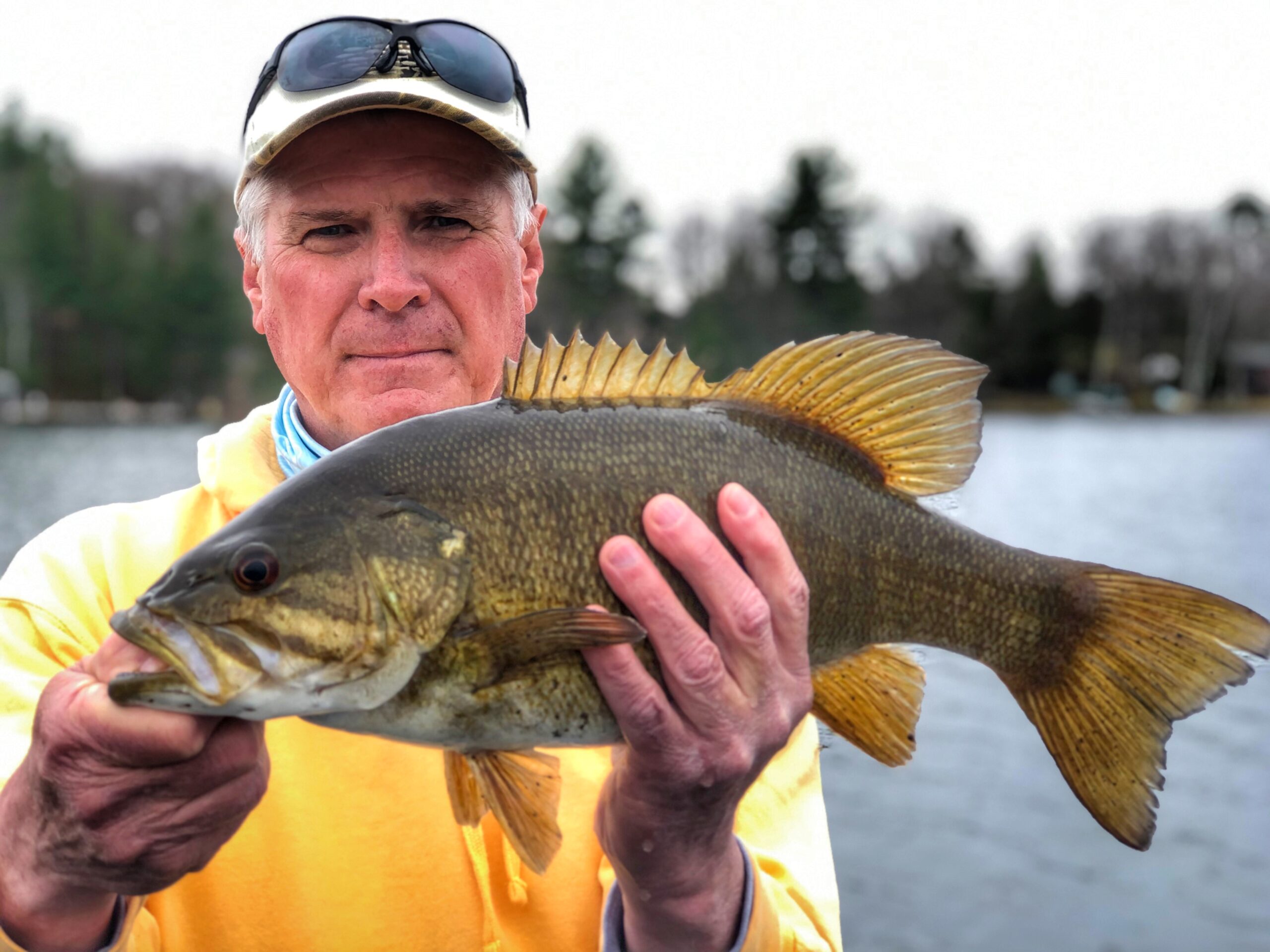
Look Deep First
Early on, smallmouths will concentrate along the base of breaks in deeper water leading up to shallow flats and spawning grounds that will be visited throughout the next few weeks. When winter is unrelenting, they can remain near wintering areas until the next warm-up.
On our northern lakes, smallmouths winter in moderately deep basins, along the base of main lake points, rock humps and ledges, or out in deep flats that vary between 20 to 50 feet (all depending upon the lake). It’s noted how ritualistic smallmouth bass are, thus they will often return to the same spawning sites and feeding flats year after year. Because of these characteristics, a sense of location and understanding of the lake’s topography is critical.
On the main lake basins, smallmouths will remain in their wintering holes for a week or two following ice-out, or until water temperatures each the mid 40’s. If you’re adept with electronics and have abilities to position atop of them, you can get onto large schools of fish.
Most fishing efforts will be taking place along the deep edges around staging sites, drop-offs, and other deeper contours.

^ Northwoods guide, Tom Kolling, of Phelps, WI is a master in ice-out smallmouths and catches them with Rippin Raps atop deep structure.
Smallmouths are found with electronics in these off shore locations. During my first outings of the year, I like to begin deep, looking for fish in the 20-to-30-foot zones. By working closely with my Lowrance HDS-12 Live that’s equipped with C-Map, I make quick drive-bys along the deepest edges of spring feeding flats, and the sides of rock humps. In these main lake locations, seeing the markings of schooling smallmouth will be obvious on-screen. Sonar as well as down imaging with fish reveal setting ON will confirm their presence.
When smallmouths rise up from their wintering holes is determined by water temperature, which is heavily influenced by sunlight and wind direction. It’s like clockwork. When the water temperature hits a certain comfort level, fish will rise from these habitats, and follow a trail of underwater structure to the shallows they will be using for feeding and spawning. Prior to reaching these ultimate destinations, they’ll settle on staging sites, homing on these locations until the spawning season officially arrives.
Up here, seasons change rapidly and weather patterns evolve quickly. Be aware that lakes can warm rapidly following ice-out, especially if warm spells are sudden and drastic. Pray that surface temperature doesn’t warm too quickly, as this has been known to shut down their activity while the rest of the water column remains cold. Oppositely, if cold weather persists throughout April and into May, then the fishing will pose several challenges, as well. Water temperatures will barely reach 50 degrees, resulting in much of the lake’s biomass and aquatic ecosystem to stall in stagnation and dormancy. If temperatures barely crack the upper-40’s, smallmouths will be likely to remain near their wintering areas.
Then Move Up Shallow
If smallmouths aren’t concentrating near wintering sites, or staging in cold water, they could be holding up tight in the extreme shallows instead. Sand pockets, isolated beaches, and shorelines with exposure to southern skies conduct heat. Smallmouths using these locations will proceed to lie on bottom, absorbing every ray. These areas are money spots for me on some lakes, even if water temperatures are 39 to 42 degrees.
On any lake map, and no matter the water temp, identify entrances of shallow bays, shoreline points, sand bars, shoals, flats, and any isolated obvious shallow structure that has been created by the shape and terrain of the lake. Smallmouths will favor rock, boulder and wood habitat, with a bottom of sand and gravel or rock in any combination at these locations, and are known to concentrate in groups along the outskirts of these areas (henceforth a staging site). Then pursue these locations if side imaging confirms presence of fish, the necessary habitat and structure, as well as perfect bottom type.
 The most active smallmouths in the lake will attract to lake regions that are warming. Most depths will be in the 5-foot range or less. The shallows with ideal bottom substrate and exposure to sun warm rapidly. They could be up to 10 degrees warmer than anywhere else on the lake. Smallmouths can gather and loiter around in depths as shallow as 1 foot to as deep as 10 feet if that’s its edge. On some lakes, it’s common to encounter several dozen large smallmouths sun-bathing in the extreme shallows, tucked up against wood for warmth and protection.
The most active smallmouths in the lake will attract to lake regions that are warming. Most depths will be in the 5-foot range or less. The shallows with ideal bottom substrate and exposure to sun warm rapidly. They could be up to 10 degrees warmer than anywhere else on the lake. Smallmouths can gather and loiter around in depths as shallow as 1 foot to as deep as 10 feet if that’s its edge. On some lakes, it’s common to encounter several dozen large smallmouths sun-bathing in the extreme shallows, tucked up against wood for warmth and protection.
Additionally, laydowns and shoreline wood will attract fish as well. It’s remarkable to observe how smallmouths congregate and pin themselves to shoreline wood located in a foot or less of water. Most smallmouths basking on these underwater microwaves are spooky and neutrally behaved, or can be negative uncatchable. But you’d be surprised by the number of desirable 3 to 4 pounders that can hold and lay in inches deep water just to absorb heat when nothing else is warming. Smallmouths frequently lay on their bellies, on bottom, like this.
I run into these scenarios often, and if a shallow water movement has begun. Exposure to sunlight is paramount to the productivity of these areas, and their likely fish availability, but we’ve also caught them under overcast skies and cold wind too.
Hair jigs and lightweight horizontal baits will catch these shallow water smallmouths.
It’s safe to say that along with numerous staging sites, a good smallmouth lake will also have many near-shore “warming sites” like these where fish will gather and warm themselves up at. Each of these locations get visited annually, and often by the same fish.
If you’re not identifying and focusing in on the sweet spots of every lake in the forms of habitat, location, and potential staging areas, you need to re-prioritize your fishing objectives.
Location always precedes strategy in my boat. My slow approach and lake coverage methodology enables us to fish meticulously and efficiently, covering all possible casting angles and approaches. We will stay atop these locations 15 to 30 minutes at a time, then revisit again throughout the afternoon in hopes for more rapid feeding windows. Feedback can often be had within the first 5 minutes of targeting these structures.
We must also fish slowly because early spring feeding windows are rapid but short lived, occurring multiple times throughout the day.
Prioritize midday and afternoon hours. The best fishing is expected to happen during periods of sunlight, and when water temperature peaks for the day.







